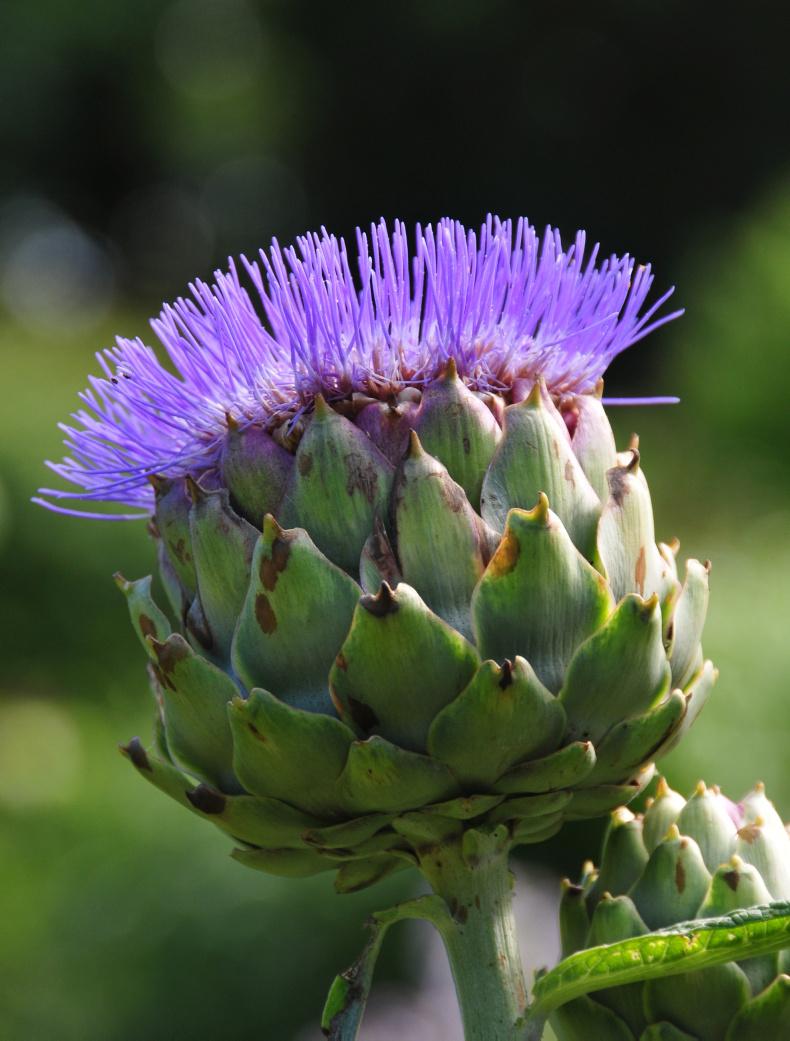Weed species of thistles include the creeping thistle and the spear thistle. Both are weeds of pasture more than gardens, but they can appear in lawns where the seeds are carried by thistledown from plants growing in badly-kept grazing land and from roadside verges. Creeping thistle can make large patches of its stems grow and spread by means of underground stems. It can appear in shrub borders and sometimes in the vegetable garden, if allowed to get established.
Spear thistle stands straight and tall, sometimes to over 2m, usually less. Although it is a weed, it has statuesque qualities that are mirrored into more decorative forms of thistle.
Thistle family
Globe artichoke is a member of the thistle branch of the greater daisy, both types, daisy and thistle, having in common their composite flower structure. The flower head is made up of scores, sometimes hundreds of small tubular florets, each a perfect single flower forming a single seed. But the thistle and daisy flowers are quite different.
The thistle has none of the outside ring of white, pink or yellow of most daisies, known as ray petals, splayed out like rays of light. The thistle flower generally has a larger, rounded base to the flower and the florets are thrust forward in purple and yellow shades. The base also builds the production of considerable amounts of thistledown.

Globe artichoke.
Salad topping
The huge flowers of globe artichokes are one of the few kinds eaten as a vegetable. The immature buds are picked about the time they reach full size and are filled with sweet, soft tissue that will be used in opening the flower buds. Indeed, the flowers open so quickly that most globe artichokes are grown for flower colour alone, often by default.
So it can be grown either as a vegetable or as a flower, in the vegetable garden or in a flower border. As a vegetable, it is easy to grow and easy to cook, just boiled and dressed with vinaigrette or olive oil and lemon. The young shoots can be covered and blanched like rhubarb in spring, covering only part of the plant that has had the foliage cut back, because the plant is evergreen and tends to harbour snails in winter.
Growing thistles
Globe artichoke has the largest thistle flowers but the plant, though broad, is not much past 1.5-2m. Cardoons, which are closely related to artichokes, growing in good soil can make 3m flower stems of silvery grey, and are often called silver cardoons. The flower buds are less than half the size of the artichokes, but can be cooked in the same way.
The silvery leaves emerge quite early in late winter and spring, and they offer a very good foliage presence right into early summer, beautifully setting off the fresh greens of spring.
In autumn, when the flowers have faded, the structural value of the large seedheads and the stems is shown. And into winter they often stand well through frost and snow. Such stems might need a cane to hold them in a windy place.
More of a knapweed than a thistle, but is part of the thistle group, the giant yellow knapweed, Centaurea macrocephala, has large yellow flowers to 2m, growing in good soil. All of these giant thistles are big plants and are more suited to a large garden, where space is not at a premium. And their naturalness makes them ideal for a country garden, if a bit super-sized.
Many alpine species have their flowering time in spring or early summer. Plants such as aubrieta, yellow aurinia, arabis, iberis and helianthmum have peaked and finished flowering by early summer, with not many candidates to follow in the show. Alpine campanulas are valuable for this purpose in the summer, in some cases others being too early.
A neat little plant for filling the gap in colour is the alpine soapwort, Saponaria ocymoides. The soapwort name refers to Saponaria officinalis, the roots of which were used to produce a soapy lather.

Tumbling Ted.
The alpine soapwort, sometimes called ‘Tumbling Ted’, is low-growing, making a broad clump, covered in pink flowers in July and into August. And true to its nickname, it tumbles nicely down a slope or retaining wall and its foam of flowering stems looks wonderful in a rock garden or patio edge.
Fruit, vegetables and herbs
Raspberry canes that have finished fruiting can be pruned out and the new canes tied into position. Sow winter lettuce to mature under a cold frame or low tunnel. Sow spring onions. Remove apples or pears, including fallen fruit attacked by wasps, to avoid even more damage.
Lawn
The grass in lawns has recovered well, having been boosted by rain. Resume regular mowing. The thunderstorms of a few weeks ago also helped by depositing nitrate salts washed out of the air after lightning. Keep lawn edges neat around beds and borders, and along paths.
Trees, shrubs and roses
Prune bush roses by removing the shoot with flowered heads to improve late flowering. Despite the rain, any garden tree that has very small leaves, planted in the last couple of years, should be watered by giving each tree one or two heavy waterings.
Flowers
Continue feeding baskets and other containers on a regular basis and keep up watering too. It is possible to collect seeds of perennial flowers, if it is desired to raise some new plants. Take cuttings of tender plants such as marguerites, fuchsias and African daisies.
Greenhouse and house plants
Continue watering and feeding greenhouse plants. Feeding should continue with flowering plants to keep them going. Continue to train and side-shoot tomatoes and cucumbers. Take the tops off tomatoes to encourage the green fruit that is already present.
Weed species of thistles include the creeping thistle and the spear thistle. Both are weeds of pasture more than gardens, but they can appear in lawns where the seeds are carried by thistledown from plants growing in badly-kept grazing land and from roadside verges. Creeping thistle can make large patches of its stems grow and spread by means of underground stems. It can appear in shrub borders and sometimes in the vegetable garden, if allowed to get established.
Spear thistle stands straight and tall, sometimes to over 2m, usually less. Although it is a weed, it has statuesque qualities that are mirrored into more decorative forms of thistle.
Thistle family
Globe artichoke is a member of the thistle branch of the greater daisy, both types, daisy and thistle, having in common their composite flower structure. The flower head is made up of scores, sometimes hundreds of small tubular florets, each a perfect single flower forming a single seed. But the thistle and daisy flowers are quite different.
The thistle has none of the outside ring of white, pink or yellow of most daisies, known as ray petals, splayed out like rays of light. The thistle flower generally has a larger, rounded base to the flower and the florets are thrust forward in purple and yellow shades. The base also builds the production of considerable amounts of thistledown.

Globe artichoke.
Salad topping
The huge flowers of globe artichokes are one of the few kinds eaten as a vegetable. The immature buds are picked about the time they reach full size and are filled with sweet, soft tissue that will be used in opening the flower buds. Indeed, the flowers open so quickly that most globe artichokes are grown for flower colour alone, often by default.
So it can be grown either as a vegetable or as a flower, in the vegetable garden or in a flower border. As a vegetable, it is easy to grow and easy to cook, just boiled and dressed with vinaigrette or olive oil and lemon. The young shoots can be covered and blanched like rhubarb in spring, covering only part of the plant that has had the foliage cut back, because the plant is evergreen and tends to harbour snails in winter.
Growing thistles
Globe artichoke has the largest thistle flowers but the plant, though broad, is not much past 1.5-2m. Cardoons, which are closely related to artichokes, growing in good soil can make 3m flower stems of silvery grey, and are often called silver cardoons. The flower buds are less than half the size of the artichokes, but can be cooked in the same way.
The silvery leaves emerge quite early in late winter and spring, and they offer a very good foliage presence right into early summer, beautifully setting off the fresh greens of spring.
In autumn, when the flowers have faded, the structural value of the large seedheads and the stems is shown. And into winter they often stand well through frost and snow. Such stems might need a cane to hold them in a windy place.
More of a knapweed than a thistle, but is part of the thistle group, the giant yellow knapweed, Centaurea macrocephala, has large yellow flowers to 2m, growing in good soil. All of these giant thistles are big plants and are more suited to a large garden, where space is not at a premium. And their naturalness makes them ideal for a country garden, if a bit super-sized.
Many alpine species have their flowering time in spring or early summer. Plants such as aubrieta, yellow aurinia, arabis, iberis and helianthmum have peaked and finished flowering by early summer, with not many candidates to follow in the show. Alpine campanulas are valuable for this purpose in the summer, in some cases others being too early.
A neat little plant for filling the gap in colour is the alpine soapwort, Saponaria ocymoides. The soapwort name refers to Saponaria officinalis, the roots of which were used to produce a soapy lather.

Tumbling Ted.
The alpine soapwort, sometimes called ‘Tumbling Ted’, is low-growing, making a broad clump, covered in pink flowers in July and into August. And true to its nickname, it tumbles nicely down a slope or retaining wall and its foam of flowering stems looks wonderful in a rock garden or patio edge.
Fruit, vegetables and herbs
Raspberry canes that have finished fruiting can be pruned out and the new canes tied into position. Sow winter lettuce to mature under a cold frame or low tunnel. Sow spring onions. Remove apples or pears, including fallen fruit attacked by wasps, to avoid even more damage.
Lawn
The grass in lawns has recovered well, having been boosted by rain. Resume regular mowing. The thunderstorms of a few weeks ago also helped by depositing nitrate salts washed out of the air after lightning. Keep lawn edges neat around beds and borders, and along paths.
Trees, shrubs and roses
Prune bush roses by removing the shoot with flowered heads to improve late flowering. Despite the rain, any garden tree that has very small leaves, planted in the last couple of years, should be watered by giving each tree one or two heavy waterings.
Flowers
Continue feeding baskets and other containers on a regular basis and keep up watering too. It is possible to collect seeds of perennial flowers, if it is desired to raise some new plants. Take cuttings of tender plants such as marguerites, fuchsias and African daisies.
Greenhouse and house plants
Continue watering and feeding greenhouse plants. Feeding should continue with flowering plants to keep them going. Continue to train and side-shoot tomatoes and cucumbers. Take the tops off tomatoes to encourage the green fruit that is already present.








 This is a subscriber-only article
This is a subscriber-only article











SHARING OPTIONS: